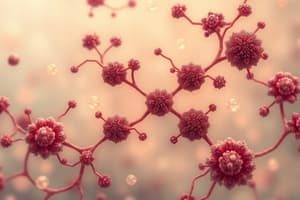Podcast
Questions and Answers
What is the main focus of pharmacokinetics?
What is the main focus of pharmacokinetics?
- What drugs do to the body
- How drugs are metabolized
- The chemical composition of drugs
- How the body processes drugs (correct)
Which of the following factors does NOT affect drug absorption?
Which of the following factors does NOT affect drug absorption?
- Presence of food
- Duration of drug action (correct)
- Age of the patient
- pH levels
What best describes the process of drug distribution?
What best describes the process of drug distribution?
- The elimination of drugs from the body
- The breakdown of drugs during metabolism
- The dispersion of drugs throughout the body's tissues (correct)
- How drugs are absorbed through the digestive tract
Which term describes how drugs leave the body?
Which term describes how drugs leave the body?
Which mechanism does NOT enhance drug absorption?
Which mechanism does NOT enhance drug absorption?
What role do transporters play in drug absorption?
What role do transporters play in drug absorption?
Which aspect impacts drug metabolism the least?
Which aspect impacts drug metabolism the least?
In terms of drug efficacy, why is distribution crucial?
In terms of drug efficacy, why is distribution crucial?
Which of the following is NOT a phase of pharmacokinetics?
Which of the following is NOT a phase of pharmacokinetics?
Which of these statements about drug absorption is correct?
Which of these statements about drug absorption is correct?
What is the primary role of plasma protein binding in drug pharmacokinetics?
What is the primary role of plasma protein binding in drug pharmacokinetics?
Which enzyme systems are primarily involved in oxidative drug metabolism?
Which enzyme systems are primarily involved in oxidative drug metabolism?
Which process adds a chemical group to make drug molecules more water soluble?
Which process adds a chemical group to make drug molecules more water soluble?
How is the concentration of a substance in a solution defined?
How is the concentration of a substance in a solution defined?
What is a significant feature of liquid chromatography mass spectrometry (LC-MS)?
What is a significant feature of liquid chromatography mass spectrometry (LC-MS)?
Which equation represents the calculation of the number of moles of a substance?
Which equation represents the calculation of the number of moles of a substance?
What effect do compartmental barriers have in pharmacokinetics?
What effect do compartmental barriers have in pharmacokinetics?
Which of the following statements about reductive drug metabolism is true?
Which of the following statements about reductive drug metabolism is true?
What does the half-life (t1/2) of a drug indicate?
What does the half-life (t1/2) of a drug indicate?
How do statins function in the body?
How do statins function in the body?
What is the primary outcome of the drug depot effect caused by lipophilic compounds?
What is the primary outcome of the drug depot effect caused by lipophilic compounds?
Which process occurs when a drug binds to a receptor that is a ligand-gated ion channel?
Which process occurs when a drug binds to a receptor that is a ligand-gated ion channel?
What does Cmax represent in pharmacokinetics?
What does Cmax represent in pharmacokinetics?
Which of the following best describes the relationship between drug exposure and the area under the curve (AUC)?
Which of the following best describes the relationship between drug exposure and the area under the curve (AUC)?
What is a plausible effect of decreased liver cholesterol synthesis due to statin use?
What is a plausible effect of decreased liver cholesterol synthesis due to statin use?
What might lead to changes in cellular physiology when a drug binds to its target?
What might lead to changes in cellular physiology when a drug binds to its target?
Which of the following is NOT a common type of cellular target for drugs?
Which of the following is NOT a common type of cellular target for drugs?
What occurs when an agonist binds to a G-protein coupled receptor?
What occurs when an agonist binds to a G-protein coupled receptor?
Which component is released from the alpha subunit upon its activation?
Which component is released from the alpha subunit upon its activation?
What happens to the alpha subunit after it associates with a target protein?
What happens to the alpha subunit after it associates with a target protein?
Which of the following correctly describes the role of the beta and gamma subunits in G-protein signaling?
Which of the following correctly describes the role of the beta and gamma subunits in G-protein signaling?
What is the effect of GTP binding to the alpha subunit?
What is the effect of GTP binding to the alpha subunit?
Which of the following statements is false regarding G-protein coupled receptors?
Which of the following statements is false regarding G-protein coupled receptors?
Which is a key feature of the G-protein coupled receptor mechanism?
Which is a key feature of the G-protein coupled receptor mechanism?
What triggers the reset of the G-protein coupled receptor system?
What triggers the reset of the G-protein coupled receptor system?
Which of these proteins is a common target for the activated alpha subunit?
Which of these proteins is a common target for the activated alpha subunit?
Which type of G-protein alpha subunit is responsible for stimulating adenylyl cyclase?
Which type of G-protein alpha subunit is responsible for stimulating adenylyl cyclase?
What process describes the phosphorylation of the receptor by its own enzyme activity?
What process describes the phosphorylation of the receptor by its own enzyme activity?
Which of these receptor types does NOT possess its own kinase activity?
Which of these receptor types does NOT possess its own kinase activity?
What is the main consequence of ligand binding to nuclear receptors?
What is the main consequence of ligand binding to nuclear receptors?
Which domain is essential for DNA binding in nuclear receptors?
Which domain is essential for DNA binding in nuclear receptors?
Which downstream signaling event can occur due to activation of G-protein coupled receptors?
Which downstream signaling event can occur due to activation of G-protein coupled receptors?
What is a primary function of accessory proteins in signaling cascades initiated by enzyme-linked receptors?
What is a primary function of accessory proteins in signaling cascades initiated by enzyme-linked receptors?
How do Guanylyl cyclase receptors primarily differ from receptor tyrosine kinases?
How do Guanylyl cyclase receptors primarily differ from receptor tyrosine kinases?
What is an example of an effect triggered by the activation of the glucocorticoid receptor?
What is an example of an effect triggered by the activation of the glucocorticoid receptor?
What role do serine, threonine, or tyrosine residues play in the signaling mechanisms of enzyme-linked receptors?
What role do serine, threonine, or tyrosine residues play in the signaling mechanisms of enzyme-linked receptors?
Flashcards are hidden until you start studying
Study Notes
Pharmacology: What the Body Does to Drugs (Pharmacokinetics)
- Pharmacology studies drug actions on the body (pharmacodynamics) and what the body does to drugs (pharmacokinetics).
- Pharmacokinetics describes how drugs are absorbed, distributed, metabolized, and excreted.
- Absorption refers to how drugs enter the body, tissues, and cells. Factors affecting absorption include physiochemical properties of the drug, environmental factors, membrane surface area, blood flow, presence of transporters, concentration gradients, pH, food, gastric emptying, age, genetic variation, health status, and diet.
- Distribution describes where drugs go in the body. This process is influenced by: plasma protein binding, lipophilicity, compartmental barriers (e.g., the blood-brain barrier) and the presence of transporters.
- Metabolism describes the chemical changes that occur to a drug in the body. There are three main types: oxidative, reductive, and conjugative.
- Excretion describes how the drug leaves the body.
Measuring and Calculating Drug Concentrations
- Drug concentrations are measured in moles/liter to determine the amount of drug present.
- A mole (mol) is 6.023 x 1023 molecules of a substance.
- Techniques like liquid-chromatography mass spectrometry (LC-MS) separate and quantify different compounds within a mixture.
Pharmacokinetic Parameters:
- Area under the curve (AUC): Represents total drug exposure.
- Half-life (t1/2): Time required for the drug concentration to decrease by half.
- Cmax: Maximum drug concentration in the body.
- Tmax: Time to reach maximum concentration.
How Drugs Work (Pharmacodynamics)
- Drugs work by interacting with cellular targets, affecting DNA, RNA, protein receptors, and enzymes.
- These interactions can activate or inhibit cellular function, alter gene expression, or stabilize/degrade proteins.
- Drugs can bind to specific receptors, which are often located on the cell membrane.
Types of Cellular Targets:
- Enzymes: Drugs can interact with enzymes by inhibiting or activating their activity. E.g., statins inhibit the enzyme HMG-CoA reductase, reducing cholesterol synthesis in the liver.
- Receptors: Drugs can bind to receptors, which are proteins that mediate cellular responses.
- Ligand-gated ion channels: Ligand binding opens ion channels, allowing ions to flow across the membrane.
- G-protein coupled receptors (GPCRs): A significant drug target, GPCRs initiate signaling pathways within cells. When an agonist binds to a GPCR, it triggers a cascade of events, involving the release of GDP and replacement with GTP, activation of downstream signaling pathways, and ultimately, the activation of target proteins.
- Enzyme-linked receptors: These receptors have a domain for ligand binding and a catalytic domain that mediates phosphorylation (adding a phosphate group). This process can activate a cascade of downstream signaling events.
- Nuclear receptors: These receptors are not membrane-bound and reside in the cytosol or nucleus. Ligand binding triggers their translocation to the nucleus and binding to DNA, ultimately regulating gene expression.
Receptor Summary
- There are various types of receptors, each with unique mechanisms of action.
- Understanding receptor function is essential for understanding how drugs work and their therapeutic effects.
Studying That Suits You
Use AI to generate personalized quizzes and flashcards to suit your learning preferences.




